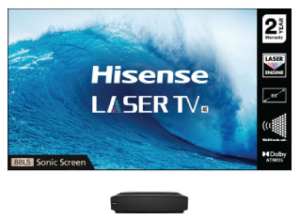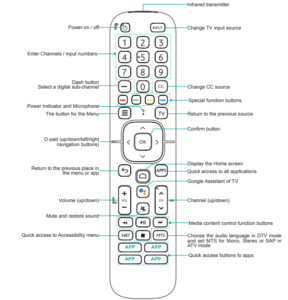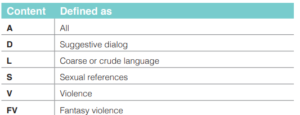Hisense 100L5F-UM LASER TV
Connecting Devices to your TV
You have several options to connect your TV to different devices. The method by which you connect will be based on the type of cables you have and the available outputs on your device. Connecting an antenna, cable set-top box, or satellite receiver To connect an antenna, cable set-top box, or satellite receiver:
- Connect one end of a coaxial cable (not included) to the RF OUT port on the antenna, cable, or satellite box. If you are using an antenna with a twin-lead cable, you may need a 300-75 Ohm adapter (not provided) to connect it to the
back of your TV. Likewise, if you are using several antennas, you may need a combiner (not provided). - Connect the other end of the cable to the ANT/CABLE port on the back of the TV.
- Using your remote, select the Inputs icon on the Home screen and select Channels as the input source. Connecting an AV device with an HDMI cable
The two high-powered HDMI version 2.0 inputs enable you to connect 4K Ultra-HD external devices that require more bandwidth to transmit to the TV screen. For example, if you have an X-box or Blu-ray player that supports the 2.0 standard.
Please refer to the User Manual that came with your device for step-by-step instructions.
To connect an AV device with an HDMI cable (not provided):
- Use an HDMI cable to connect the HDMI output port of the AV device to the HDMI port of the TV.
- Plug the connected devices into the HDMI port on the TV before switching it on.
- Using your remote, select the Inputs icon in the Home screen and select the corresponding HDMI input.

NOTES
- Because the HDMI connector provides video and audio signals, it is not necessary to connect an audio cable.
- We strongly recommend using an HDMI Cable with 2 cores as shown in the figure.
Connecting speakers or other audio receivers
To connect speakers or other audio receivers with an audio cable (not provided):
- Use an audio cable to connect the digital audio in port of the audio receiver device to the DIGITAL AUDIO OUT port of the TV. Another option is to use an audio cable to connect an analog sound system to the AUDIO OUT port of the
- Plug the connected devices into the main power socket before switching on the TV.

- TIP: If you prefer to use the Audio Return Channel, then see Connecting an audio device to use the Audio Return Channel (ARC) on page 6.
NOTES
- When a digital audio system is connected to the DIGITAL AUDIO OUT port, decreases the TV and system volume.
- 5.1 CH (channel) audio is available when the TV is connected to an external device that supports a 5.1 channel surround sound when using the Audio Return Channel (ARC) feature
Connecting an audio device to use an Audio Return Channel (ARC)
If you’d like to use the Audio Return Channel (ARC) feature to have sound sent from the TV back down an HDMI cable to an audio device, then you will need to connect the cable to the HDMI / ARC port. By using this feature, you will also be able to control the audio device with your TV remote instead of having to use multiple remotes for each device. To connect an audio device with an HDMI cable (not provided):
- Connect the audio device to the HDMI / ARC port on the TV.
- Make sure your audio device is powered on.
- Press the Home button on your remote and select the Settings icon, then go to Sound > Speakers.
- Select the ARC option.

NOTE
• If the audio device has an Input Selector feature then set it to the proper input. Connecting a USB device You can connect USB devices such as hard drives, USB sticks, and digital cameras for browsing photos, listening to music, and watching recorded movies.
- Connect a USB device to the USB port.
- Select the Media type on the Media screen. For more information, see Media on page 28
NOTES
- When connecting a hard disk or a USB hub, always connect the main adapter of the connected device to the power supply. Exceeding a total current consumption may result in damage. The USB 2.0 port supports a
- maximum current of 500mA. The USB 3.0 port supports a maximum current consumption of 1A. • Certain devices may require higher than 1A, and those are not supported.
Connecting Your TV to a Wired Network
You have the option to connect your TV to a wired network to access the Internet. For more information about the network settings on TV, see Network & Internet on page 22 Connecting to a wired (Ethernet) network You can attach your TV to your LAN in one of the three following ways:
- Option 1
You can attach your TV to your LAN by connecting the LAN port on the back of your TV to an external modem using a Cat 5 LAN cable. See the illustration below
- Option 2
You can attach your TV to your LAN by connecting the LAN port on the back of your TV to an IP Sharer which is connected to an external modem. Use an Ethernet cable for the connection. See the illustration below.
- Option 3
Depending on how your network is configured, you may be able to attach your TV to your LAN by connecting the LAN port on the back of your TV directly to a network wall outlet with an Ethernet cable. See the diagram below.
If you have a Dynamic Network, you should use an ADSL modem or router that supports Dynamic Host Configuration Protocol (DHCP). Modems and routers that support DHCP automatically provide the IP address, subnet mask, gateway, and DNS, so you don’t have to enter them manually. Most home networks are Dynamic Networks. Some networks require a Static IP address. If your network requires a Static IP address, you must enter the IP address, subnet mask, gateway, and DNS values manually on your TV’s Cable Setup Screen when you set up the network connection. To get the IP address, subnet mask, gateway, and DNS values, contact your Internet Service Provider (ISP). NOTE
- You can use ADSL modems that support DHCP if your network requires a static IP address. ADSL modems that support DHCP also let you use static IP addresses.
Using Your TV Remote Control
Buttons on your TV remote
Remote control range information
The remote control can work at a distance of up to 26 feet in front of the TV set. ( This distance is used by infrared means in an unpaired state.) It can work at a 30-degree horizontal or 15-degree vertical angle. ( This angle is used by infrared means in an unpaired state.) Begin using your remote
- Take off the back cover to open the battery compartment of the remote control.
- Insert two AAA-size batteries. Make sure to match the (+) and (-) ends of the batteries with the (+) and (-) ends indicated in the battery compartment.
- Restore the battery compartment cover.
NOTES
- Discard batteries in a designated disposal area. Do not throw them into a fire.
- Remove old batteries immediately to prevent them from leaking into the battery compartment.
- If you do not intend to use the remote control for a long time, remove the batteries.
- Battery chemicals can cause a rash. If the batteries leak, clean the battery compartment with a cloth. If chemicals touch your skin then wash it immediately.
- Do not mix old and new batteries.
- Do not mix alkaline, standard (carbon-zinc), or rechargeable (NiCd, NiMH, etc.) batteries.
- Do not continue using the remote if it gets warm or hot.
- Call our Support Center immediately on the support website. Program your universal cable or satellite remote control to operate your new television (only for the USA)
If you would like to program your other household remote controls to your new television, please refer to the User’s Manual supplied by your Cable or Satellite provider. The Cable or Satellite providers’ User Manuals should include instructions on how to program their remote to your television. A list of codes for the most common Cable and Satellite providers are listed below. Use the code that is associated with your Cable or Satellite provider (if applicable).
- DIRECTV
0178, 10178, 10019, 10748, 11314, 11660, 11710, 11780, 12049, 10171, 11204, 11326, 11517, 11564, 11641, 11963, 12002, 12183 - Time Warner Cable
386, 0178, 10178, 400, 450, 461, 456, 0748, 1463, 0463, 10463 Comcast 0178, 10178, 10463, 11463, 10748, 11314, 11660, 10171, 11204, 11326, 11517, 11641, 11780, 11785, 11892, 11963, 12002 - Cox Communications
0178, 10178, 1326, 1463 - Dish Network
505, 627, 538, 720, 659 If the code associated with your Cable or Satellite provider is not listed, does not work or you cannot locate the instructions to program your remote, call your local Cable or Satellite provider’s customer service center. If your Cable or Satellite provider does not have a code available, please contact us. Using your cable set-top box or satellite receiver remote as a ‘universal’ remote If you prefer to use your Cable Set-top Box or Satellite Receiver Remote as a ‘Universal Remote’, then visit the Support page to view a list of the codes.
Pairing the Remote Control
- Pair the remote to the TV after you power it on. Keep the remote control within 10 feet of the TV. Press and hold the [ ] button for at least 3 seconds to start pairing.
- If the remote is paired successfully then a confirmation will display on the screen. If it did not pair successfully then an unsuccessful message will display. Repeat step 1.
NOTE
- If an unknown error occurred with the remote then it could have been caused by interference. Try to remove what’s causing the interference and pair it again.
- If an unknown error occurs in the remote control while the battery power is normal, you can take out the batteries and press any key for 1~2 seconds, then the remote control can work normally.
- The remote cannot be paired to the TV while the TV is in standby mode.
Completing the Setup Assistant Menu
Plug the power cord into an AC outlet, the TV will turn on. After the splash screen that displays the logo appears, begin the Setup Wizard menu. The guide setting is completed according to the boot navigation prompt. The navigation information is specific to the actual condition. The Home screen will be your starting point for navigating the TV
Shortcuts Instructions
You can use shortcuts on the remote control for fast operation. Turning your TV on or off To turn your TV on:
- Connect the power cord to the back of the TV, then plug the power cord into an AC outlet.
- When the TV is powered on, press the [ ] button on the remote to turn on the TV. To turn your TV off, press the [ ] button on the remote.
NOTES
- When your TV is in standby mode, it is still consuming power. To completely disconnect power, please remove the plug from the AC outlet.
- If your TV does not receive an input signal for several minutes, it automatically goes into standby mode.
Using the Live TV
To view broadcast programs, press the Home button to access the Home screen on your remote, select the Inputs icon on the Home screen, and select Channels as the input source. Channel search guide When you select Channels as input, if no TV channels were saved before, you will be prompted to do a channel search. You can also go to Menu > Channels to change the channel settings. Launch Live TV After channel scanning is done for the first time, the screen will display a Livet operating tutorial, including how to Load the info Bar, how to load the channel list, and so on.
- [ Up ] Load info bar
- [ OK ] Load channel list
- Load onscreen menu
- Jump to the previous channel
- Viewing channel information
- As you use the [ CH / ] button on your remote to scroll through channels, an information banner appears on the top of the screen.
The information banner displays the following information:
- Channel number
- Lock status
- Input
- Program name
- Show identification
- Channel name
- Current date and time
- Beginning and end times of the next program
- Start/Stop time progress bar of the current program
- Prompt
- Favorite channel
If you are watching a particular channel, you can also press the [ Up ] button of your remote to view channel information.
Viewing a channel list
After you have done an automatic channel scan (if you’re using an antenna) or receive your channels through a cable provider, you can view your list of channels by pressing [OK] on your remote. You will see the channel list display on the right side of the screen.
Creating a Favorite List
- To quickly access your most-watched channels, you can create a Favorite List in one of two ways.
- The first way is to create your Favorite List in Menu:
- Press the [ ] button to access the Menu in Channels source.
- Select Channels > Favorite List.
- Using the [Up / Down] buttons of your remote, select a channel and press the [OK] button.
The second way is to create your Favorite List in the channel list:
- Press the [OK] button to call out the channel list in the Channels source.
- Select a channel and add it by using the green button.
- heart-shaped indicator will appear beside the channel as confirmation that it has been successfully added.
Viewing your Favorite list
To view channels that you’ve added to your Favorite List simply press [OK] on your remote to call out the channel list. The channel list appears on the right side of the screen and heart-shaped icons are shown next to the channels that make up your Favorite List. You can press the [ Left / Right ] buttons to switch the channel list (ANTENNA or CABLE), FAVORITE and HISTORY list.
Using shortcuts
- Google Assistant
You can press the [ ] button to turn on your Google Assistant, use your voice to ask it questions and tell it to do things. - Closed Caption (CC)
You can switch between Off, On, and On when mute. - Narration (NRT)
You can switch between Video Description On and Video Description Off. - Audio Language (MTS)
You can choose the audio language in DTV mode and you can set MTS for Mono, Stereo, or SAP in ATV mode.
Home
Getting familiar with the Home screen The simple design of the Home screen menu makes it easy to navigate. And you can easily add or delete applications in the Home interface according to your needs. To access the Home screen, press the Home button on your remote control and use the D-pad to make your selection. Indicators and Icons on the top of the Home screen Google Search: You can search movies, TV, and more by speaking or typing.
Notifications: Notifications can come from the system, an external device, an application, the media player, etc. Inputs: Select the Input source depending on the device you have connected to your TV. Network & Internet: You can set up the Network & Internet. Settings: Settings lets you configure the TV, set app options, add accounts, and change other preferences. Time: You can always view the current time at the top right corner of the Home screen. Names of sections that appear on the Home screen
The Home screen displays the following section names:
- Apps
- Feature Apps
- Recommended content
Menu
Your TV comes with many TV setting features to allow you to customize the picture based on your viewing preference and environment. As you navigate through different screens to access settings, some of the indicators appear as words On and Off. Using the Menu You can press the [ ] button to access the Menu in TV mode. The Menu consists of the following settings:
- Picture
- Screen
- Sound
- Channels
- Parental Control
- Audio Only
- Live TV Closed Captioning
- Audio Language(MTS)
- Sleep Timer
- Settings
- Help
In each menu, you can:
- Press the [Up / Down] buttons to select an item.
- Press the [OK] buttons to enter the sub-menu or to set it on or off.
- Press the [Left / Right] buttons to adjust the value.
- Press the [ ] button to return to the previous menu.
Picture
- Light Level: Adjust how bright you want images to appear, lower settings create darker images.
- Picture Mode: If you’d like to configure the settings for your picture, then there are some types of picture modes available.
- Once you choose the mode, you can adjust the picture based on the following settings:
- Contrast: Adjust the Contrast level to increase or decrease how bright images appear.
- Brightness: Adjust the Brightness level to generate lighter or darker images.
- Color: Adjust the color intensity of the picture for a more vibrant image.
- Tint: Adjust the colors from a green to a magenta tint to view the natural skin tones of people on the screen.
- Sharpness: Adjust how sharp or soft edges of images appear.
- Picture Size: Adjust the Aspect Ratio to stretch or zoom in on your picture. You can choose from the following
settings: Auto, Normal, Zoom, Wide, Direct, Dot-By-Dot, Panoramic, or Cinema. - HDMI 2.0 Format: Match the connected device output format. You can select Standard format and Enhanced format in HDMI mode. Enhanced format for devices of 4K@50/60Hz (YCbCr4:4:4, YCbCr4:2:2).
- Advanced Settings: Adjust advanced picture settings based on your viewing preference.
- Overscan: Change the video size settings to slightly crop the edges of the displayed image.
- Color Temperature: Select a preset color temperature. Adjust how warm(red) or cool(blue) the white areas of an image appear.
- Motion Enhancement: This setting minimizes afterimages that are left on the screen when viewing fast-moving objects. You can adjust it from Off, Custom, Film, Clear, Standard or Smooth. A Smooth setting will produce an 18 smoother picture whereas a Clear setting will result in a picture that has less judder (shaking).
NOTE
- Some models don’t support this function.
- Noise Reduction: Improve how clear the picture appears by reducing noise.
- Digital Noise Reduction: Improve picture clarity by reducing video noise.
- HDMI Dynamic Range: Adjust the HDMI signal range to be more suitable for the content. (HDMI mode only)
- Active Contrast: Automatically darken dark areas and lighten light areas of images to see more details.
- Color Space: Change the range of colors the TV displays.
- Some models don’t support this function. Calibration settings: Adjust the color space and Gamma to best suit the content you’re viewing.
- Color Tuner: Adjust the Hue, Saturation, and Brightness of color settings.
- White Balance: Adjust the intensity of red, green, and blue lights to view the true colors of all images in the picture.
- Gamma Calibration: Adjust the selected Gamma curve.
- RGB only: View images based on default settings or choose the color red, blue, or green. Apply Picture Settings: Adjust the current picture mode to apply to all sources or just the current source. Reset: Reset current picture settings to factory mode.
Screen
- Projection mode: Flip the image over top-to-bottom and/or left-to-right based on the positioning of your TV. Auto geometric correction: Follow the on-screen prompts to complete the geometric correction step by step.
- Geometric correction: Adjust the position of the point by pressing the UP/DOWN/LEFT/RIGHT buttons.
- Eye protection: To protect your eyes, do not look into the lens. This projector is shutting down in 5 seconds, The TV screen is closed immediately.
Sound
- System sounds: Open the default system sound.
- Sound Mode: Select a preset sound mode to suit the type of content you are listening to Standard,
- Theater, Sports, Concert Hall, Music, Speech, Late Night and User Mode.
- Once you choose the mode, you can adjust the audio based on the following settings:
- Speakers: Select the speakers that you want to use: TV Speaker, ARC, or Bluetooth.
- Optimizes overall sound quality by increasing bass, making dialog clear and natural, and widening the sound field.
- Provides surround sound experience with psycho-acoustic processing to place sounds beside,
- behind, and above the viewer. For best results use Total Sonics.
- Maintains consistent loudness levels from wide dynamic range programs, loud commercials, and
- channel or input changes. Advanced Settings: Tune the audio settings and quality of the TV.
- Balance: Adjust the left and right speaker strength to optimize audio for a specific location.
- Digital Audio Out: Select the digital audio out format that best suits the audio device type. For example, choose
- DDP (Dolby Digital Plus) if you have an AV device that supports Dolby Digital Plus 5.1. Choose PCM if you have an amplifier that does not support Dolby Digital technology.
NOTE
- When connected to the TV with optical, DDP is not suggested.
- If your audio device supports Dolby Digital, then select DD; if not, select PCM.
- Digital Audio Delay: Adjust the digital audio out delay time to sync sound from an external speaker with the images on the TV.
- Lip Sync: Synchronize the displayed image with the audio output.
- Equalizer: Boost the volume at different frequencies.
- Preferred Audio Language: Set the default audio output language for the type of digital broadcast content that you’re viewing.
- Reset: Reset current audio settings to factory mode.
Channels
- Tuner Mode: Select if you receive TV channels over the air (antenna) or through a cable set-top box. Auto Channel Scan: Automatically scan for channels.
- Manual Scan: Type in a channel to add it manually to your TV.
- Channels Skip: Skip selected channels from your Channel List.
- Favorite List: Add Channels to your Favorite List.
Parental Control
The Parental Control setting allows you to block content that is not appropriate for children to watch. turning Parental Control On
Press the [OK] button on your remote to turn Parental Control on. 2. Create PIN window displays. Using the D-pad on your remote, create the password. You will see the other Parental Control settings change from a greyed-out state to a highlighted one. When this occurs, begin adding other settings to the Scheduled Blocking, Channel Blocking, Program Blocking, Input Blocking, Change
PIN or Rest features
Scheduled Blocking: Block all selected channels and programs during selected periods. Channel Blocking: Block selected channels. Program Blocking: Block programs by ratings. For more information about Ratings, See Description of U.S. TV
Ratings on page 19.
- Open V-Chip: Turn this On to automatically block programs based on the US rating.
- Block Unrated: Block or unblock unrated movies. Input Blocking: Block selected inputs.
- Change PIN: Change the PIN that you use to access Parental Control.
NOTE
- If you forget your password, call the Consumer Electronics Care Center.
- Reset: Reset Parental Control back to the factory setting.
Description of U.S. TV Ratings
Device Preferences
Amazon Alexa Service
- Use your voice to control the TV, other smart home devices, and more.
- Amazon Alexa Service: Turn on and off Alexa service.
- Amazon Alexa Service Setup: Set up accounts to use Alexa service.
- Setup Checklist: Check the current settings of Alexa and guide the user to set up.
- Things to try: Show the main functions that Alexa can support currently.
Date & time
- Automatic date & time: Use network-provided time. You can also set the current time manually when Off is selected.
- Set date: Set the date.
- Set time: Set the time.
- Set time zone: Select your time zone.
- Use 24-hour format: Set the time to display in a 12 or 24-hour format.
Timer
- Sleep Timer: Set the sleep timer to automatically turn the TV off within a specified time: off, 10 Minutes, 20 Minutes,
- 30 Minutes, 40 Minutes, 50 Minutes, 60 Minutes, 90 Minutes and 120 Minutes.
- Power On Timer Type: Set the type Off, Daily, Once.
- Power On Timer: Set the clock for the time you want the TV to turn on automatically.
- Power Off Timer Type: Set the type Off, Daily, Once.
- Power Off Timer: Set the clock for the time you want the TV to turn off automatically.
Language
Adjust the default Language settings for the TV.
Keyboard
- Adjust the default settings for the keyboard.
- Storage
- You can view the TV storage.
Home screen
Customize channels: Add or delete the app icon from the Home screen. Enable video previews: Enables or disables the video previews. Enable audio previews: Enables or disables the audio previews.
Reorder apps / Reorder games: Rearrange the Apps screen.
Android TV Home / Android TV Core Services: See the information on open-source software licenses
Apps
Numerous factory-installed apps are available for you to choose from for your entertainment preferences. Installing an App To install an app:
- From the Home screen, click on the Apps and select Get More Apps.
- Use the navigation buttons on your remote to select the app that you want to install.
- Select the INSTALL.
Removing an App
You can only delete apps that you’ve installed on the TV. Factory-installed apps can not be deleted. To delete an app:
- From the Apps screen, use the navigation buttons on your remote to select the app that you want to remove. Long press the [OK] button on your remote.
- Click on Uninstall.
- A dialog message displays that asks do you want to uninstall this app. Confirm and the icon is removed from the Apps screen.
NOTE
If an app is deleted, the information related to that app is also removed. Moving App Icons Around To move an app:
- From the Apps screen, use the navigation buttons on your remote to select the app that you want to move. Long press the [OK] button on your remote.
- Click on Move.
- Use the navigation buttons on your remote to move the location of the app. Press the [OK] button to confirm
Media
- Media is a central location for you to view or listen to different types of content (for example, your photos, music, and movies) through the following methods:
- A USB thumb drive or hard drive
- Compatible mobile phone, tablet, or other personal devices: You can stream movies, music, and photos that are stored on a Compatible personal device and play or view the content on your TV. File formats that may be supported
NOTE
- Due to differences in programming tools and other factors, some of the file formats that are listed may or may not be supported.
Browsing Content
To browse through content based on the type that you wish to access:
- Navigate to the appropriate menu tab on the screen and select All Media, Videos, Photos, and Music.
- Click on the name of the folder that contains your content.
- Make your selection to play or view the content. If you want to close out of the Media center, then press the [BACK] button on your remote.
Quick Problem-Solving Tips
When you experience an issue with your TV, turn it off and on again. If this does not resolve the problem, then refer to the tips below. If the problem is still not resolved, then contact us.




